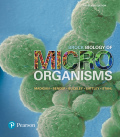
EBK BROCK BIOLOGY OF MICROORGANISMS
15th Edition
ISBN: 8220103633352
Author: Stahl
Publisher: PEARSON
expand_more
expand_more
format_list_bulleted
Concept explainers
Question
Chapter 24.10, Problem 1MQ
Summary Introduction
Clostridium difficile is an inhabitant of intestinal microflora of humans. It usually develops when the person is on increased dose of antibiotics. The intake of antibiotics disrupts the normal flora of the intestine due to which C. difficile gains an opportunity to grow in the intestine and therefore, establish an infection. The common symptom of C. difficile infection are recurrent diarrhea, colitis (inflammation of colon), and abdominal cramps.
Expert Solution & Answer
Want to see the full answer?
Check out a sample textbook solution
Students have asked these similar questions
What is behavioral adapt
22. Which of the following mutant proteins is expected to have a dominant negative effect when over-
expressed in normal cells?
a. mutant PI3-kinase that lacks the SH2 domain but retains the kinase function
b. mutant Grb2 protein that cannot bind to RTK
c. mutant RTK that lacks the extracellular domain
d. mutant PDK that has the PH domain but lost the kinase function
e. all of the above
What is the label ?
Chapter 24 Solutions
EBK BROCK BIOLOGY OF MICROORGANISMS
Ch. 24.1 - Which major body sites are heavily colonized by...Ch. 24.1 - What methods have been used to assess the human...Ch. 24.1 - Prob. 3MQCh. 24.1 - Prob. 1CRCh. 24.2 - How does the general metabolism of microorganisms...Ch. 24.2 - What is an enterotype?Ch. 24.2 - QHow do microbial diversity and abundance vary...Ch. 24.3 - Prob. 1MQCh. 24.3 - Identify the major microbes that predominate in...Ch. 24.3 - Prob. 3MQ
Ch. 24.3 - Prob. 1CRCh. 24.4 - Prob. 1MQCh. 24.4 - Prob. 2MQCh. 24.4 - Prob. 1CRCh. 24.5 - Prob. 1MQCh. 24.5 - Prob. 2MQCh. 24.5 - Prob. 1CRCh. 24.6 - Prob. 1MQCh. 24.6 - Prob. 2MQCh. 24.6 - Prob. 3MQCh. 24.6 - What are the major anatomical differences between...Ch. 24.7 - Prob. 1MQCh. 24.7 - Prob. 2MQCh. 24.7 - What factor(s) are most important in the...Ch. 24.7 - Prob. 1CRCh. 24.8 - Prob. 1MQCh. 24.8 - Prob. 2MQCh. 24.8 - Prob. 3MQCh. 24.8 - Prob. 1CRCh. 24.9 - What observations indicate that dental carries are...Ch. 24.9 - Prob. 2MQCh. 24.9 - What are some clinical advantages of a...Ch. 24.9 - Why might a therapy based on colonization of the...Ch. 24.10 - Prob. 1MQCh. 24.10 - Prob. 2MQCh. 24.10 - Prob. 1CRCh. 24.11 - Prob. 1MQCh. 24.11 - Prob. 2MQCh. 24.11 - What is the mechanism by which C. scindens...Ch. 24 - Prob. 1AQ
Knowledge Booster
Learn more about
Need a deep-dive on the concept behind this application? Look no further. Learn more about this topic, biology and related others by exploring similar questions and additional content below.Similar questions
- Can you described the image? Can you explain the question as well their answer and how to get to an answer to an problem like this?arrow_forwardglg 112 mid unit assignment Identifying melting processesarrow_forwardGive only the mode of inheritance consistent with all three pedigrees and only two reasons that support this, nothing more, (it shouldn't take too long)arrow_forward
- Oarrow_forwardDescribe the principle of homeostasis.arrow_forwardExplain how the hormones of the glands listed below travel around the body to target organs and tissues : Pituitary gland Hypothalamus Thyroid Parathyroid Adrenal Pineal Pancreas(islets of langerhans) Gonads (testes and ovaries) Placentaarrow_forward
- What are the functions of the hormones produced in the glands listed below: Pituitary gland Hypothalamus Thyroid Parathyroid Adrenal Pineal Pancreas(islets of langerhans) Gonads (testes and ovaries) Placentaarrow_forwardDescribe the hormones produced in the glands listed below: Pituitary gland Hypothalamus Thyroid Parathyroid Adrenal Pineal Pancreas(islets of langerhans) Gonads (testes and ovaries) Placentaarrow_forwardPlease help me calculate drug dosage from the following information: Patient weight: 35 pounds, so 15.9 kilograms (got this by dividing 35 pounds by 2.2 kilograms) Drug dose: 0.05mg/kg Drug concentration: 2mg/mLarrow_forward
- A 25-year-old woman presents to the emergency department with a 2-day history of fever, chills, severe headache, and confusion. She recently returned from a trip to sub-Saharan Africa, where she did not take malaria prophylaxis. On examination, she is febrile (39.8°C/103.6°F) and hypotensive. Laboratory studies reveal hemoglobin of 8.0 g/dL, platelet count of 50,000/μL, and evidence of hemoglobinuria. A peripheral blood smear shows ring forms and banana-shaped gametocytes. Which of the following Plasmodium species is most likely responsible for her severe symptoms? A. Plasmodium vivax B. Plasmodium ovale C. Plasmodium malariae D. Plasmodium falciparumarrow_forwardStandard Concentration (caffeine) mg/L Absorbance Reading 10 0.322 20 0.697 40 1.535 60 2.520 80 3.100arrow_forwardPlease draw in the missing answer, thank youarrow_forward
arrow_back_ios
SEE MORE QUESTIONS
arrow_forward_ios
Recommended textbooks for you
 Concepts of BiologyBiologyISBN:9781938168116Author:Samantha Fowler, Rebecca Roush, James WisePublisher:OpenStax College
Concepts of BiologyBiologyISBN:9781938168116Author:Samantha Fowler, Rebecca Roush, James WisePublisher:OpenStax College- Case Studies In Health Information ManagementBiologyISBN:9781337676908Author:SCHNERINGPublisher:CengageSurgical Tech For Surgical Tech Pos CareHealth & NutritionISBN:9781337648868Author:AssociationPublisher:Cengage



Concepts of Biology
Biology
ISBN:9781938168116
Author:Samantha Fowler, Rebecca Roush, James Wise
Publisher:OpenStax College

Case Studies In Health Information Management
Biology
ISBN:9781337676908
Author:SCHNERING
Publisher:Cengage

Surgical Tech For Surgical Tech Pos Care
Health & Nutrition
ISBN:9781337648868
Author:Association
Publisher:Cengage

12DaysinMarch, Genital Infections for USMLE Step One; Author: Howard Sachs;https://www.youtube.com/watch?v=66zR_FypVFQ;License: Standard youtube license